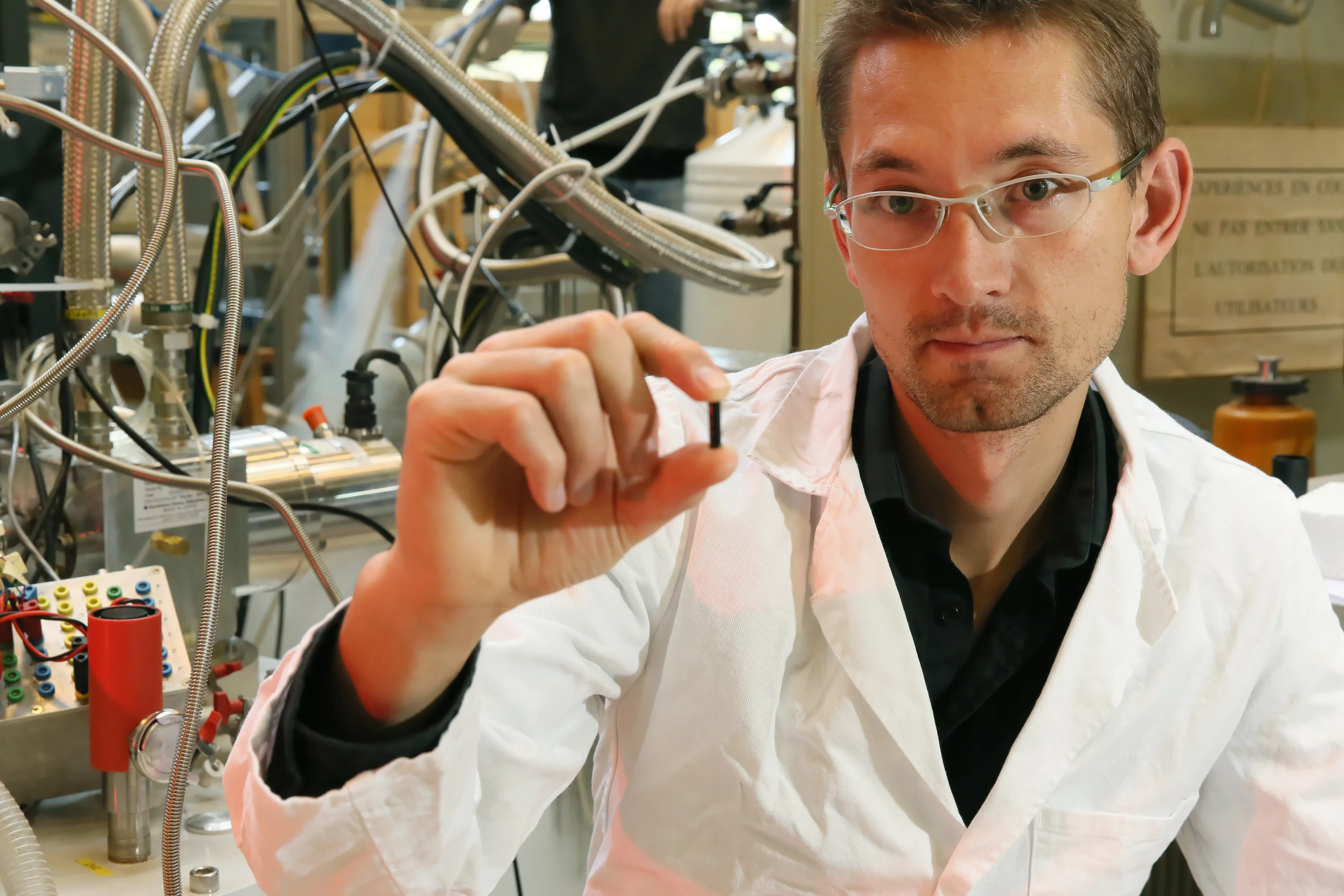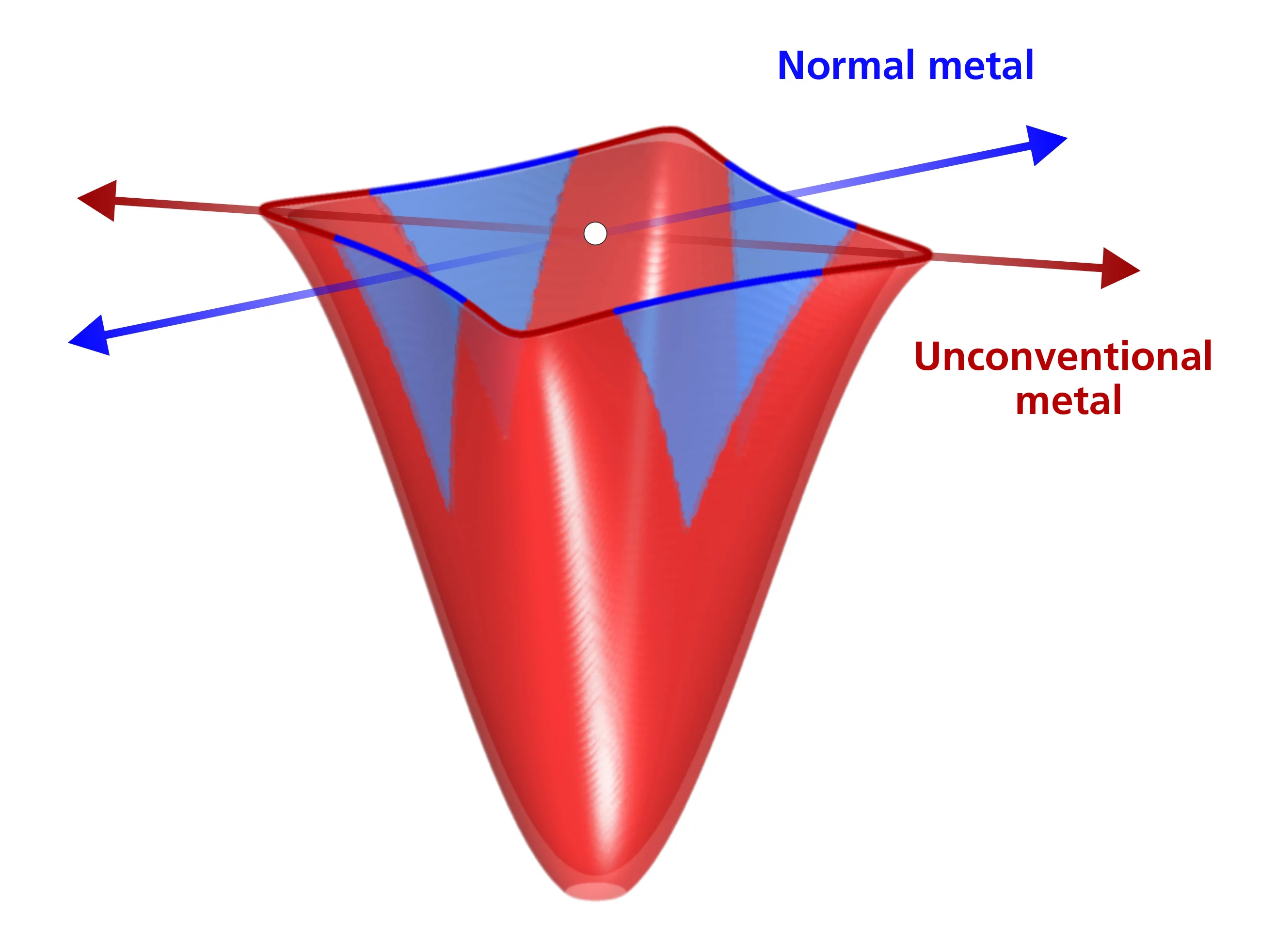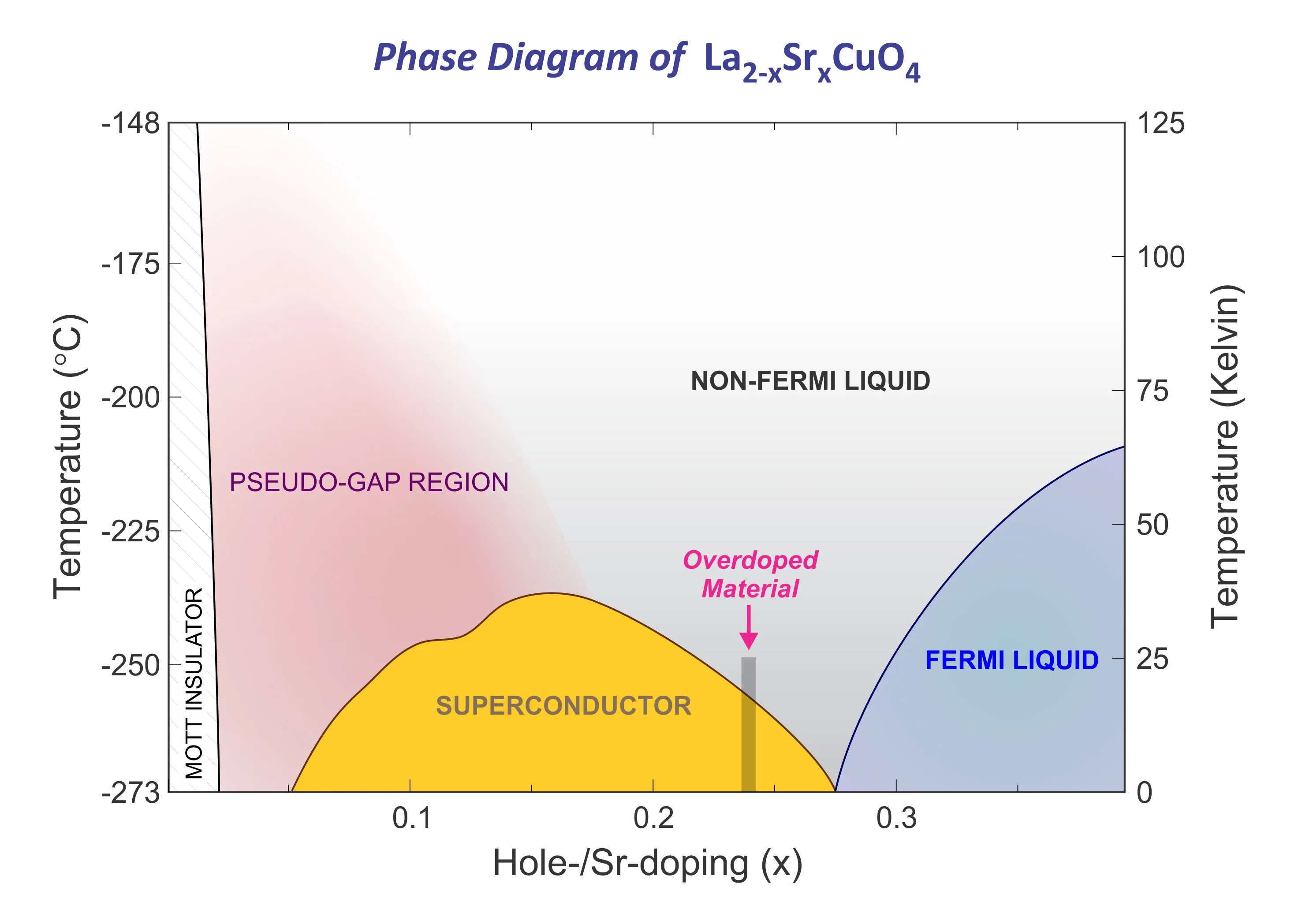Some electrons in a superconducting material behave as if they were in a conventional metal, others as in an unconventional one – depending on the direction of their motion.
Understanding the origins of high-temperature superconductivity, the ability of some materials to conduct electricity without any resistance and therefore without loss of energy, is one of the most important quests of modern physics. It is also highly relevant for technical applications since it would allow the development of superconductors with properties tailored to suit various possible applications. Important insights can be gained from investigating superconducting materials at temperatures above the transition temperature, i.e. the temperature above which the superconducting property is lost. In collaboration with colleagues from Sweden, France and England, researchers from the Paul Scherrer Institute have now investigated the interactions of the electrons responsible for conducting electricity in the high-temperature superconductor La1.77Sr0.23CuO4 above the transition temperature. Experiments performed at the Paul Scherrer Institute’s Swiss Light Source showed that the electrons in the material have a “split personality” – they can behave in two different ways in one and the same material. Electrons moving in some directions behave as if they were in a conventional metal such as gold or iron, while for other directions their behaviour corresponds to a more exotic unconventional metal. The discovery of this unexpected anisotropy makes an important contribution towards understanding high-temperature superconductors. In addition, the effect will have to be taken into account in future experiments and theories of high-temperature superconductors. The results have been published in the journal Nature Communications.
Electron interactions in superconducting material depend on direction of momentum
The red and blue arrows indicate high-symmetry directions in momentum space.
The figure illustrates how electrons along one high-symmetry direction (blue) behave as in a conventional metal but along another direction (red) they have unconventional behavior.
Understanding the origins of high-temperature superconductivity, the ability of some materials to conduct electricity without any resistance and therefore without loss of energy, is one of the most important quests of modern physics. It is also highly relevant for technical applications as it would allow the development of superconductors with properties tailored to suit the various possible applications for these materials. Example applications include the lossless transport of electricity over large distances, more efficient MRI scanners and maglev trains, and superfast computers. Despite its name, high-temperature superconductivity is in fact only observed at rather low temperatures. At higher temperatures – above the transition temperature – the behaviour of the material changes and the superconducting properties disappear. Nevertheless, understanding the properties of the material in its non-superconducting state is important to determine the underlying mechanism of high-temperature superconductivity.
Conventional or unconventional – depending on momentum
With this in mind, researchers from the Paul Scherrer Institute teamed up with colleagues from Sweden, France and England to investigate the interactions of the electrons responsible for conducting electricity in the high temperature superconductor La1.77Sr0.23CuO4 above the transition temperature. It was clear from earlier experiments that the electronic properties of the material were different from those of a conventional metal such as iron or gold. The PSI researchers’ goal was to look at the behaviour of the electrons in detail by probing the material with synchrotron light from PSI’s Swiss Light Source. It turned out that the properties of the electrons in the material depend strongly on the direction of their momentum, i.e. their direction of motion. For one symmetry direction, the electrons behave as if they were in a conventional metal, while for other directions their behaviour corresponds to an unconventional metal instead. The discovery of this unexpected anisotropy makes an important contribution towards the understanding of electrical conduction in high-temperature superconductors. In addition, such an effect will have to be taken into account in future experiments and theories of high-temperature superconductors. Up until now, the interaction of the electrons has generally been assumed to be isotropic.
What is a metal?
Generally speaking, a metal is a material that conducts heat and electricity. As is commonly known, metals get hot when an electrical current passes through it. The electric current corresponds to a stream of electrons moving through the metal. On their way through the metal, the electrons bump into other electrons or into the atoms making up the structure of the material. With every such bump, the electrons lose some of their energy of motion and transmit it to the other electron or atom. This way, some of the electric energy transported by the electrons is lost. This effect is the origin of electric resistance. In the collisions, the energy is transferred to the other particles and makes them move more rapidly. But while the original electrons making up the current move in a coordinated manner, the particles they bumped into move in a rather chaotic way – a kind of motion that corresponds to what we experience as heat. In a sense, high-quality energy is transformed into low-quality energy.
A very successful mathematical description of the behaviour of electrons in conventional metals such as copper, gold or silicon was introduced by the Russian physicist Lev Landau in 1956. One of the measurable consequences of this so called Fermi-liquid theory is the way resistivity depends on temperature. (Resistivity is a measure for how strongly a particular material opposes the flow of electricity. Resistivity is the general property of a material, while electric resistance is the property of a particular object, i.e. also depends on the object’s size.) In terms of electrons, resistivity corresponds to the mean free path of the electrons, i.e. the distance an average electron covers before bumping into something – the shorter the mean free path, the higher the resistivity. Generally, the higher the temperature the higher the resistivity because the particles the electrons can collide with are moving faster at higher temperatures which makes collisions more likely. In Fermi-liquid theory, at low temperatures, resistivity is proportional to the square of the temperature, i.e., when you double the temperature, the resistivity will be quadrupled. More importantly, resistivity becomes zero at zero temperature which corresponds to the electrons moving completely uninhibited. (By zero temperature we mean “absolute zero”, By zero temperature we mean “absolute zero”, which is not zero degrees Celsius, but the lowest possible temperature, which is close to -273 degrees Celsius). Any other dependence of the resistivity on temperature is a sign of unconventional behaviour.
Using synchrotron light to watch electrons move
The fact that the material investigated here is an unconventional metal has been determined by measuring its resistivity. “But the resistivity measurements only provide a rough picture of the electron interactions in the material” explains Johan Chang, head of the research team at PSI, who is now working at EPFL. “We wanted to examine the electrons’ behaviour in detail.” For that purpose, the scientists investigated the material at the SIS beamline at the Swiss Light Source of the PSI. In their experiment, they shone ultraviolet synchrotron light onto their sample. Such high-intensity light dislodges electrons from the sample through a process called the photoelectric effect. By recording both the energy and direction of motion of the ejected electrons with high precision, the scientists were able to determine the properties that the electrons had inside the sample itself: their binding energy (how strongly the material resists the removal of the electrons) and their momentum (i.e. the way they moved). The method is known as ARPES (angle-resolved photoelectron spectroscopy). While analysing their data, the scientists were particularly interested in the fact that when the measurement was performed on a large number of electrons, all in the same state inside the material, the energy measured was not exactly the same for all of them, but rather displayed a distribution. Such a distribution occurs because the quantum states of the electrons do not live forever. This corresponds to the observation described above that electrons collide with other particles and thus change their direction of motion and consequently their quantum state. “One can imagine the lifetime of the electron as the time the electron is able to move freely before bumping into another electron and thus changing into a different quantum state”, explains Chang.
Electrons show a split personality
The way the lifetime depends on the binding energy and momentum reveals whether the electrons follow the Fermi liquid model or not. As already mentioned, it turned out that in the material investigated here, the electrons actually behave differently for different directions of motion. For some directions, they move as if they were in a conventional metal, for others they show unconventional behaviour. Thus, in a sense, the electrons seem to have a split personality.
Such a discovery shows that this superconductor is in fact both a conventional and unconventional metal at the same time, depending on which direction is considered. “Our current results show that studies of the normal state of superconducting materials are indeed crucial to understand them”, concludes Martin Månsson, a materials scientist at the PSI and EPFL and co-author of the paper. “They also display how important it is to use a combination of standardized bulk techniques, such as resistivity measurements, and state-of-the-art momentum-resolved methods like ARPES to obtain an accurate description of the electronic properties in these complex compounds.”
Overdoped material
Most high-temperature superconductors belong to a group of complex ceramic materials called Perovskites. They are typically based on a so-called parent compound that is usually an insulator. To obtain a superconductor, the parent compound is doped, i.e. a small number of the atoms are replaced by atoms of a different element that provide the carriers necessary for transporting electric current – electrons or “holes”. Here, the parent compound is La2CuO4 and the doped material is La2-xSrxCuO4, with x being the fraction of lanthanum (La) atoms replaced by strontium (Sr). The material becomes superconducting for a whole range of values for x, but there is an optimal value where the transition temperature reaches a maximum. For higher values of x the transition temperature decreases again – the material is said to be “overdoped”. For even higher values, the material loses its superconducting properties completely and becomes a conventional metal described by the Fermi liquid model at low temperatures. The material investigated here was an example of the overdoped case close to the Fermi liquid. The presence of electrons interacting according to the Fermi liquid model might reflect the proximity of this state in the phase diagram.
About PSI
The Paul Scherrer Institute develops, builds and operates large, complex research facilities, and makes them available to the national and international research community. The Institute's own key research priorities are in the investigation of matter and material, energy and the environment; and human health. PSI is Switzerland's largest research institution, with 1500 members of staff and an annual budget of approximately 300 million CHF.
Contact
Dr Johan Chang, Swiss Light Source, Paul Scherrer Institute, 5232 Villigen PSI;now at the Institute of Condensed Matter Physics, École Polytechnique Fédérale de Lausanne (EPFL), 1015 Lausanne, Switzerland;
Phone: +41 21 6935811; E-mail: johan.chang@epfl.ch
Dr Martin Månsson, Laboratory for Neutron Scattering LNS, Paul Scherrer Institute, 5232 Villigen PSI
and Laboratory for Quantum Magnetism (LQM), École Polytechnique Fédérale de Lausanne (EPFL), 1015 Lausanne, Switzerland;
Phone: +41 56 310 5534; E-mail: martin.mansson@psi.ch
Original Publication
Anisotropic breakdown of Fermi liquid quasiparticle excitations in overdoped La2-xSrxCuO4J. Chang, M. Månsson, S. Pailhès, T. Claesson, O. J. Lipscombe, S. M. Hayden, L. Patthey, O. Tjernberg & J. Mesot
Nature Communications 4, 2559 doi:10.1038/ncomms3559




